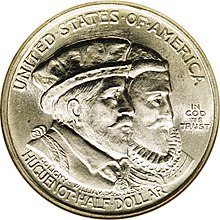United States | |
| Value | 50 cents (0.50 U.S. dollars) |
|---|---|
| Mass | 12.5 g |
| Diameter | 30.61 mm (1.20 in) |
| Thickness | 2.15 mm (0.08 in) |
| Edge | Reeded |
| Composition |
|
| Silver | 0.36169 troy oz |
| Years of minting | 1924 |
| Mintage | 142,080 including 80 pieces for the Assay Commission |
| Mint marks | None, all pieces struck at the Philadelphia Mint without mint mark. |
| Obverse | |
 | |
| Design | Jugate busts of Gaspard de Coligny (left) and William the Silent |
| Designer | George T. Morgan, based on sketches by John Baer Stoudt |
| Design date | 1924 |
| Reverse | |
 | |
| Design | The ship Nieuw Nederlandt |
| Designer | George T. Morgan, based on sketches by John Baer Stoudt |
| Design date | 1924 |
The Huguenot-Walloon half dollar or Huguenot-Walloon Tercentenary half dollar is a commemorative coin issued by the United States Bureau of the Mint in 1924. It marks the 300th anniversary of the voyage of the Nieuw Nederlandt which landed in the New York area in 1624. Many of the passengers were Huguenots from France or French-speaking Walloons from what is now Belgium; they became early settlers of New York State and the surrounding area.
A commission run by the Federal Council of Churches in America sought issuance of a half dollar to mark the anniversary, and the bill passed through Congress without opposition in 1923 and was signed by President Warren G. Harding. Sketches were prepared by commission chairman Reverend John Baer Stoudt and converted to plaster models by the Mint's aging chief engraver, George T. Morgan. The models were initially rejected by the Commission of Fine Arts, which required revisions under the supervision of Buffalo nickel designer James Earle Fraser.
Of the 300,000 coins authorized by Congress, fewer than half were actually struck, and of these, 55,000 were returned to the Mint and released into circulation. The coin excited some controversy because of its sponsorship by a religious group. The choice of William the Silent and Gaspard de Coligny to appear on the obverse was also questioned as the men are considered martyrs by the Huguenots and died decades before the voyage of the Nieuw Nederlandt. The coins are currently valued in the hundreds of dollars, depending on condition.
